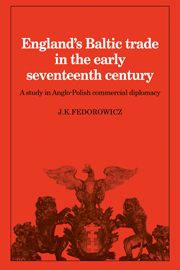 England's Baltic Trade in the Early Seventeenth Century
England's Baltic Trade in the Early Seventeenth Century Book contents
- Frontmatter
- Contents
- Preface
- List of maps and graphs
- List of abbreviations
- Map
- Introduction
- 1 English perceptions of the Polish Commonwealth
- 2 The mechanics of English diplomacy in the Eastland
- 3 The early history of the Eastland Staple at Elbing
- 4 The operation of the staple
- 5 The pattern of English shipping into the Baltic
- 6 English exports to the Baltic
- 7 English imports from the Baltic
- 8 The threat to the Eastland Staple at Elbing
- 9 The depression of 1620 and the crisis of England's Baltic trade
- 10 The political crisis, 1620–9
- 11 The mission of Sir Thomas Roe to the Eastland
- 12 Attempts at reconciliation with Danzig, 1630–5
- 13 The climax of English commercial diplomacy, 1635–42
- 14 Conclusion
- Notes
- Bibliography
- Index
11 - The mission of Sir Thomas Roe to the Eastland
Published online by Cambridge University Press: 05 November 2011
- Frontmatter
- Contents
- Preface
- List of maps and graphs
- List of abbreviations
- Map
- Introduction
- 1 English perceptions of the Polish Commonwealth
- 2 The mechanics of English diplomacy in the Eastland
- 3 The early history of the Eastland Staple at Elbing
- 4 The operation of the staple
- 5 The pattern of English shipping into the Baltic
- 6 English exports to the Baltic
- 7 English imports from the Baltic
- 8 The threat to the Eastland Staple at Elbing
- 9 The depression of 1620 and the crisis of England's Baltic trade
- 10 The political crisis, 1620–9
- 11 The mission of Sir Thomas Roe to the Eastland
- 12 Attempts at reconciliation with Danzig, 1630–5
- 13 The climax of English commercial diplomacy, 1635–42
- 14 Conclusion
- Notes
- Bibliography
- Index
Summary
The purpose behind English mediation
The deteriorating military situation in Germany, commercial blockade in the Baltic, and renewed depression in England combined to arouse the English government from its lethargy. The year 1629 saw Habsburg armies besieging the Baltic port of Stralsund while English shipping to the Eastland was reduced to a trickle. In England itself wool prices fell, trade decayed, and a parliamentary crisis over tunnage and poundage paralysed the government. In addition to the German and Baltic wars, England was trying to extricate itself from futile conflicts with France and Spain that merely added to the general insecurity which was having a fatal effect on the nation's livelihood. Whatever its weaknesses, the government of Charles I could no longer afford to ignore these problems; the decision to intervene diplomatically in the Baltic was simply the logical response to the host of ills that had been allowed to accumulate for so long.
In a sense, the Baltic could be considered a key to the solution of everything else. By successfully mediating in the war between Sweden and Poland, the English government would free the ambitious Gustav Adolf to save German Protestantism by direct intervention, would restore peace and free trade to the Baltic, and this in turn would revive demand for English cloth and renew Baltic supplies of important commodities, both of which would alleviate the depression in England itself. Successful mediation might add prestige to Charles's government and not only deflect some Parliamentary criticisms but also place England in a stronger position to negotiate with France and Spain. On all counts, therefore, successful mediation promised fair returns for a minimal investment.
- Type
- Chapter
- Information
- England's Baltic Trade in the Early Seventeenth CenturyA Study in Anglo-Polish Commercial Diplomacy, pp. 188 - 206Publisher: Cambridge University PressPrint publication year: 1980


